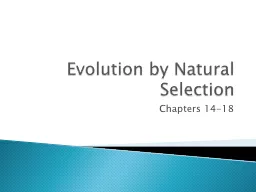

Chapters 1418 Charles Darwin DOB 1809 On the Origin of Species by Means of Natural Selection HMS Beagle 183136 Greeks life arose in water and more complex followed simpler ones ID: 783134
Download The PPT/PDF document "Evolution by Natural Selection" is the property of its rightful owner. Permission is granted to download and print the materials on this web site for personal, non-commercial use only, and to display it on your personal computer provided you do not modify the materials and that you retain all copyright notices contained in the materials. By downloading content from our website, you accept the terms of this agreement.
Slide1
Evolution by Natural Selection
Chapters 14-18
Slide2Charles
Darwin
, DOB 1809, On the Origin of Species by Means of Natural Selection, HMS Beagle – 1831-36Greeks – life arose in water and more complex followed simpler onesLater Aristole said life was fixed (ps. he’s wrong)Judeo-Christians agreedMid 1700s fossils of “strange animals” were foundJean Baptiste de Lamark suggested acquired traits were inherited. Used = got better, Unused = go away. (ps…he’s half wrong)
History
Slide3Dad wanted him to get into medicine, then he went to become a priest – Met John
Henslow
– took a cruise.While on the boat he read Principles of Geology by Charles Lyell. “mountains rise cm by cm” The way the rain falls today is the same way it fell 1billion years ago.UNIFORMITARIANISMLearned about Thomas MalthusHuman population should be huge but - War, Disease, Famine limits the populationHistory
Slide4So Darwin is on a cruise…
Finds sea animal fossils thousands of feet above sea level
Finds FINCHES similar to the mainland but 600miles out to sea GALAPAGOS ISLANDS Realizes that kids look like parentsAfter his trip, he thinks about this stuff for a little while…like 20yearsAlfred Wallace sends him a paper that is the same idea that he has come to and Darwin quickly publishes. The conclusion…? History
Slide5Organisms that exist today are modified versions of older organisms.
The environment chooses the organisms that are best fit to reproduce (natural selection).
The better fit the organism the more babies it will produce, the more of those genes are in the gene pool.Traits that help an organism survive better and make more babies are ADAPTATIONSDescent with Modification
Slide61. Fossils
2. Biogeography
3.Homologous/Analogous Structures4. Embryology5. Molecular Biology (macromolecules)6. Vestigial StructuresEvidence – 6 pieces
Slide7Traces of long dead organisms
Sediments
Law of superposition:Which happened first, tree falling or it snowed?Fossil Record:The theoretical ‘stack’ of all fossils, in order1. Fossils
Slide8Align and fix the locations in place. Answer the following questions:
Which locality is the oldest? How do you know?
Which locality is the youngest? Where might you find this in the Earth’s crust?Approximately how many years are represented in your localities? Are there any huge gaps?Why aren’t all the fossils in the same place?Is there a pattern to the complexity of the fossils?How do fossils form? What does this tell you about the organisms that we find as fossils (or what about the one’s we don’t find)?Do you think fossils are strong evidence for evolution? Why or why not.Fossil Lab
Slide9Organisms that are relatively close (NJ and PA) are more alike than organisms that are far apart.
More pouched animals in
AustrailiaGalapagos Finches2. Biogeography
Slide10‘Homo’ means … so these are parts in different species of animals that are the same.
Analogous – same function but different structure
3.Homologous/Analogous Structures
Slide11Figure 13.11
Slide12In the early stages
of development,
many species are similar.4. Embryology
Slide13Large compounds in organisms are sometimes similar
Protein
HemoglobinStarch5. Molecular Biology (macromolecules)
Slide14Remnants of structures that served a purpose in ancestral organisms but have little or no function now.
Appendix
Wisdom teethTails6. Vestigial Structures
Slide15The organism that is best fit to the environment makes the most babies and passes on the most genes.
DEPENDS COMPLETELY ON GENETIC MAKEUP
Individual variation (longer legs, sharper teeth, darker color)If its not the environment choosing but people we call it ARTIFICIAL SELECTIONCowsSheepBacteriaChemicals - ddtNatural Selection
Slide16Gene pool – all of the genes in a population
Population – a group of mating individuals in the same place at the same time.
We can identify if evolution is taking place based on the Hardy-Weinburg Equationp2 + 2pq + q2 = 1Certain events can cause evolution to occur more quicklyBottle neck eventFounder eventGene flow – immigration, emmigrationMutation
Slide17Figure 13.22
Slide18Figure 13.23
Slide19Sometimes evolution occurs in a specific pattern
Directional Selection
Disruptive SelectionStabilizing Selection
Slide20Names and groups organisms according to their characteristics and evolutionary history
Carolus
Linnaeus (1707-1778)Binomial NomenclatureSpecies identifierVarieties- peach and nectarineSubspecies – different areaA species is defined as organisms that can reproduce and form fertile offspring.Taxonomy
Slide21Systematics – classification in the context of evolution
Fossil record
MorphologyPhylogenic treeCladistics – derived charactersCladogramsWeird relationshipsSystematics vs Cladistics
Slide22Domains –
Eukarya
BacteriaArchaeaKingdomPhylumClassOrderFamilyGenusSpecies
Slide23Animalia
Plantea
FungiProtistaEubacteriaAcheabacteriaKingdoms (Modern Bio p348-9)
Slide24What is living?
Order
Regulation/HomeostasisGrowth and DevelopmentEnergy UtilizationRespond to the environmentReproductionEvolutionSpontaneous Generation- living things from nonliving things (frogs came from mud)Francesco REDI 1650: Disproved spontaneous generation with meat, flies, jarsLazzaro SPALLANZANI 1750: Disproved spontaneous generation with boiled broth, new story-vital forceLouis PASTEUR 1850: Disproved both spontaneous generation and vital force with s-shaped flaskStory of Life
Slide25Slide26Miller and Urey Experiment on how life began
Water + ammonia +
CO2 + Nitrogen =Organic compounds!PROKARYOTESEndosymbiosis-Lynn Margulis 1950One or a few microorgsLiving together becameour organelles =EUKARYOTESStory of Life
Slide27Found everywhereKingdoms Bacteria,
Archaea
Mostly unicellular and very smallNo nucleus or organellesShapes: Bacilli, cocci, spirochetePhotoauto/heterotroph- Chemoauto/hetero- how they eatPathogenProkaryotes
Slide28Lynn Margulis
-
endosymbiont theorySmaller prokary climbed inside larger prokay and was happy togetherKingdoms Protista, Plant, Fungi, AnimalsLarger cells, have nucleus and organellesVERY diverseEukaryotes